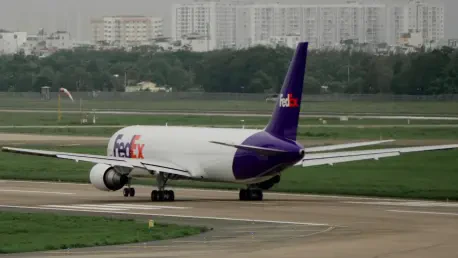In a landscape where the aerospace industry faces intense competition and scrutiny, Boeing has emerged as a focal point of resilience and recovery, showcasing a remarkable ability to rebound from past setbacks with a robust delivery performance. Recent data reveals that the company is on pace for its strongest annual delivery numbers in years, a testament to strategic leadership and operational recalibration. Under the guidance of CEO Kelly Ortberg, Boeing is navigating a path of cautious optimism, prioritizing quality enhancements and production boosts to regain trust and market share. This surge in deliveries, particularly with popular models like the 737 MAX and 787 Dreamliner, signals a pivotal moment for the aerospace giant. As Boeing works to close the gap with its European competitor, Airbus, the focus on consistent output and a healthy order backlog paints a picture of a company determined to solidify its standing in the global market, while addressing lingering challenges with precision and purpose.
Robust Delivery Numbers Driving Momentum
Boeing’s delivery performance in October stands as a clear indicator of its accelerating recovery, with 53 jets handed over to various clients, contributing to a year-to-date total of 493 aircraft. This figure positions the company on track for its highest annual delivery count since 2018, a significant milestone after years of turbulence. The majority of October’s deliveries comprised 39 units of the 737 MAX, the company’s flagship narrowbody jet, with major airlines like Southwest and Ryanair among the recipients. Additionally, widebody aircraft such as the 787 Dreamliner and 777 freighters played a crucial role, showcasing Boeing’s versatility across market segments. This diverse portfolio not only meets commercial demand but also extends to military applications, as seen with deliveries for specialized conversions like the P-8 maritime patrol plane. The steady pace of deliveries reflects an operational rhythm that Boeing has fought to restore, underscoring a commitment to meeting customer expectations while rebuilding confidence in its manufacturing capabilities.
Beyond the monthly figures, the broader implications of Boeing’s delivery trends highlight a strategic push to stabilize and grow its output in a competitive arena. The year-to-date total of 493 jets, while trailing Airbus’s 585, demonstrates a narrowing gap and a focused effort to reclaim market dominance. The emphasis on the 737 MAX, a model once mired in controversy, now represents a cornerstone of Boeing’s recovery narrative, with incremental production increases signaling regulatory and public trust. Widebody deliveries, including 13 units in October, further illustrate the company’s ability to cater to long-haul and cargo needs, a segment critical for future growth. This balance between narrowbody and widebody production ensures Boeing remains adaptable to fluctuating market demands. As delivery numbers climb, they serve as a barometer of operational health, reflecting not just quantity but a renewed focus on reliability and customer satisfaction that could define Boeing’s trajectory in the coming years.
Strategic Leadership and Quality Focus
Under the stewardship of CEO Kelly Ortberg, Boeing has embarked on a transformative journey, placing production quality at the forefront of its recovery strategy. After enduring significant challenges, including the grounding of the 737 MAX following tragic incidents and subsequent quality concerns, the company has shifted gears to prioritize safety and precision in its manufacturing processes. A notable achievement in this regard is the recent approval from the Federal Aviation Administration to ramp up 737 production to 42 jets per month, up from 38. This incremental boost is more than a numerical gain; it represents a vote of confidence in Boeing’s ability to address past issues and meet rising demand. Ortberg’s leadership has been instrumental in steering the company toward operational excellence, ensuring that each aircraft rolling off the line adheres to stringent standards, a move aimed at rebuilding trust with airlines and regulators alike.
This focus on quality extends beyond regulatory approvals to tangible expansions in Boeing’s production capabilities, particularly for the 787 Dreamliner. The company is enhancing its facilities in South Carolina to accommodate growing demand for this widebody model, which has already secured 320 orders this year, marking one of the highest annual totals for the aircraft. Such investments signal a long-term vision to strengthen Boeing’s position in the lucrative long-haul market, where efficiency and range are paramount. The emphasis on quality control, paired with capacity growth, reflects a dual strategy of addressing immediate production bottlenecks while laying the groundwork for sustained output. As Boeing navigates this path, the interplay between leadership decisions and operational improvements becomes a critical factor in maintaining momentum. The company’s ability to balance these priorities will likely determine how effectively it can capitalize on current successes and transform them into enduring market strength.
Order Backlog and Market Confidence
Boeing’s order activity, while modest in October with a net gain of eight new orders after cancellations, tells a broader story of market confidence when viewed through the lens of year-to-date figures. With 782 new orders secured after adjustments, the company boasts a backlog of 5,911 aircraft, a robust pipeline that ensures future production stability. The 787 Dreamliner, in particular, has emerged as a standout, with significant orders reflecting strong demand for widebody jets in an era of expanding global travel. Recent interest from Central Asian airlines for additional 787s further underscores the model’s appeal in emerging markets. This backlog not only provides a buffer against short-term fluctuations but also positions Boeing as a reliable partner for airlines planning fleet expansions, reinforcing its role as a key player in the aerospace sector despite competitive pressures.
Financial indicators also paint a picture of growing investor trust in Boeing’s recovery efforts, as evidenced by a year-to-date stock gain of 13.4%. This modest yet positive movement suggests that the market sees value in the company’s operational strides, from delivery milestones to strategic expansions. The diversity of Boeing’s order book, spanning both commercial and military applications, adds another layer of resilience, mitigating risks associated with any single segment. While Airbus maintains a lead in delivery numbers, Boeing’s substantial backlog and focus on high-demand models like the 787 indicate a competitive edge in specific niches. The challenge lies in converting this backlog into timely deliveries without compromising on quality, a balancing act that will test the company’s operational discipline. As market dynamics evolve, Boeing’s ability to sustain order momentum and translate it into consistent output will be a defining factor in its long-term recovery narrative.
Building Toward a Sustainable Future
Reflecting on Boeing’s journey, the strides made in delivery performance during October, with 53 jets handed over, marked a significant chapter in the company’s recovery story. The year-to-date total of 493 aircraft delivered showcased a determined push toward reclaiming past highs, while strategic decisions under CEO Kelly Ortberg’s guidance prioritized quality and capacity growth. Incremental production boosts for the 737 MAX and expansions for the 787 Dreamliner in South Carolina highlighted a forward-thinking approach. Though order gains were limited in the latest month, the substantial backlog of 5,911 aircraft stood as a testament to enduring demand. Even as Boeing trailed Airbus in overall deliveries, the steady stock performance reflected a market belief in its potential. Moving forward, the focus should center on sustaining this delivery pace while ensuring quality remains uncompromised. Exploring partnerships for technological innovation and streamlining supply chains could further bolster output. As Boeing builds on these achievements, maintaining regulatory trust and customer confidence will be key to securing a lasting resurgence in the aerospace landscape.









